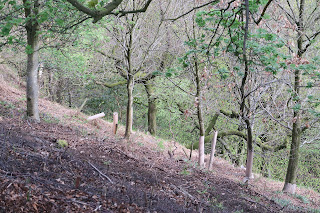Eleven of us turned out on a damp, mizzly kind of day including Peachysteve who organised the event and Andy Mclay from Natural England. To be honest, one look at the mainly long, sodden grass made me think that this was an impossible task to find anything of note but with so many keen eyes on the ground we had a pretty decent haul by the end of the trip.
This Glutinous Earthtongue was the first decent species and was extremely well picked out by one young lady. The head was so smooth and slimy you can even see my reflection in it.
Thirteen species of Waxcaps were found including this Goblet Waxcap.
.......and this rather pretty Spangle Waxcap.
A nice clump of Yellow Clubs
It's the first time I've had any pinkgills named for me so it was good to finally see this Mealy Pinkgill
......and this Priest's Hat Pinkgill (Entoloma infula). It had no English name until it was fancifully imagined by Peachysteve.
This unearthed Scarlet Caterpillarclub had an unusual amount of fruit bodies so I wondered if it was from a particularly large moth larva such as an Emperor Moth, but I was soon reminded that these pupate above ground. Turns out it was just a regular sized (noctuid?) larvae.
As expected the large amount of cow pats contained fungi including these "eyelash" fungi. Such was their abundance I'm fairly confident they're Cheilymenia fimicola - a very common species.
A lateral view shows smaller hairs on the underside of the cup.
Another highlight for myself were these much sought after Horsehair Parachutes. The caps measure around 3mm across and their stems are like, you guessed it, horsehair. I was already at the back of the party when I found these, so that when I'd finished photographing them I was all on my own, in an drizzly, exposed field in the middle of nowhere and the light was fading fast - quite surreal really.
Lunch was taken overlooking the Cragg valley - we all enjoyed the chocolate brownies one kind lady had baked for us.
Fungi expert Andy Mclay is on the left.
FULL LIST RECORDED
Clavulinopsis fusiformis Golden Spindles
Clavulinopsis helvola Yellow Club
Clavulinopsis luteoalba Apricot Club
Clitocybe nebularis Clouded Funnel
Cordyceps militaris Scarlet Caterpillar Club
Cystoderma amianthinum Earthy Powdercap
Entoloma infula Priest's Hat Pinkgill
Entoloma prunuloides Mealy Pinkgill
Galerina sp Bell
Geoglossum glutinosum Glutinous Earthtongue
Hygrocybe cantharellus Goblet Waxcap
Hygrocybe chlorophana Golden Waxcap
Hygrocybe coccinea Scarlet Waxcap
Hygrocybe conica Blackening Waxcap
Hygrocybe insipida Spangle Waxcap
Hygrocybe irrigata Slimy Waxcap
Hygrocybe laeta Heath Waxcap
Hygrocybe pratensis Meadow Waxcap
Hygrocybe psittacina Parrot Waxcap
Hygrocybe quieta Oily Waxcap
Hygrocybe reidii Honey Waxcap
Hygrocybe russocoriacea Cedarwood Waxcap
Hygrocybe virginea Snowy Waxcap
Laccaria laccata Deceiver
Lactarius quietus Oakbug Milkcap
Lycoperdon nigrescens Dusky Puffball
Mucilago crustacea Dog's Vomit Slime Mould
Mycena epipterygia Yellowleg Bonnet
Mycena pura Lilac Bonnet
Paneolus sp Mottlegill
Psilocybe semilanceata Liberty Cap
Rhodocollybia butyracea Buttercap
Scleroderma citrinum Common Earth Ball
Stropharia semiglobata Dung Roundhead
Agaricus sp Mushroom
Tubaria dispersa Hawthorn Twiglet
Rickenella fibula Orange Mosscap
Cheilymenia sp Dung Eyelash Fungus
Clitocybe fragrans Frangrant Funnel
Boletus luridiformis Scarletina Bolete






















































